Rooftop gardens offer a unique opportunity to blend nature with urban living, enhancing both aesthetics and mood. By carefully selecting color schemes and plant varieties, these green spaces can transform stark rooftops into vibrant retreats that promote tranquility and visual appeal. Thoughtful design not only beautifies the cityscape but also fosters a connection to nature in bustling urban environments.
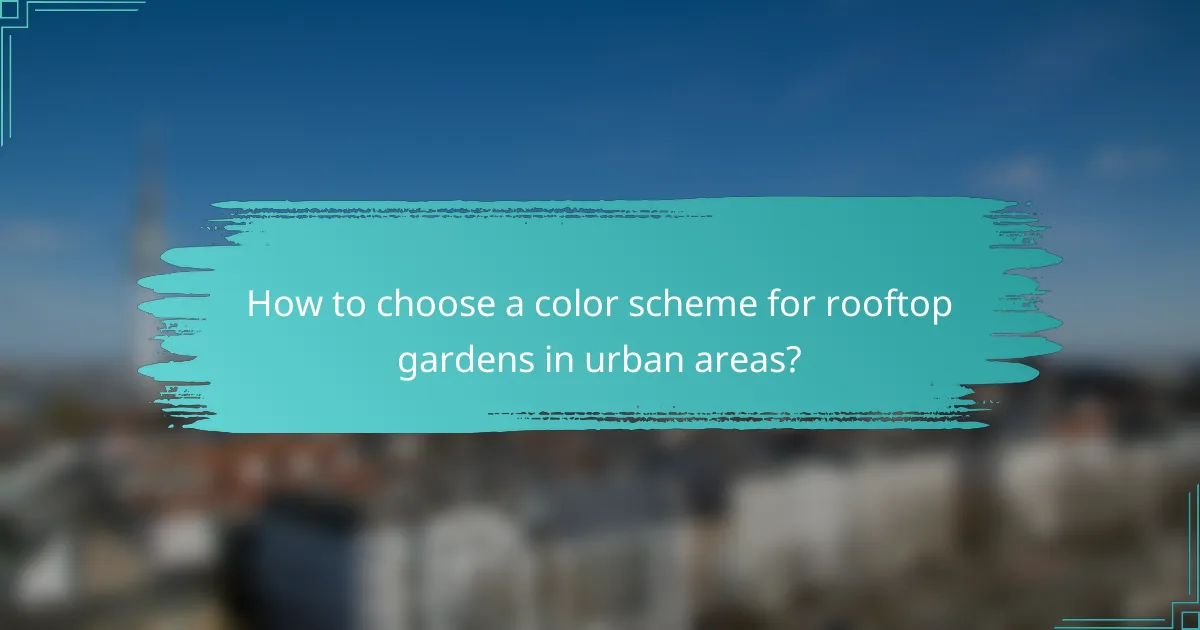
How to choose a color scheme for rooftop gardens in urban areas?
Choosing a color scheme for rooftop gardens in urban areas involves considering the local environment, architectural styles, and the psychological effects of colors. A well-thought-out color palette can enhance the aesthetic appeal and create a serene atmosphere amidst the urban landscape.
Consider local climate
Local climate plays a crucial role in selecting colors for rooftop gardens. Warmer climates may benefit from cooler colors like blues and greens, which can create a refreshing feel, while cooler climates might use warmer tones like yellows and reds to evoke warmth. Additionally, lighter colors can help reflect sunlight and keep spaces cooler, while darker shades absorb heat.
When planning your garden, consider the seasonal changes in your area. For example, if your city experiences harsh winters, choose colors that remain vibrant even in the colder months, such as evergreen plants or colorful planters.
Match colors with surrounding architecture
Matching your rooftop garden’s color scheme with the surrounding architecture can create a cohesive look. Observe the dominant colors and materials of nearby buildings; for instance, if the area features a lot of brick or concrete, earthy tones or vibrant greens can provide a pleasing contrast. This approach helps the garden blend in while still standing out as a unique feature.
Consider using similar color accents found in the architecture, such as window frames or railings, to create harmony. This can be achieved through planters, furniture, or even the choice of flowering plants that echo the architectural palette.
Use color psychology for mood enhancement
Color psychology can significantly influence the mood of rooftop garden spaces. For instance, blue hues are often associated with calmness and tranquility, making them ideal for relaxation areas. In contrast, vibrant colors like red and orange can energize and stimulate conversation, suitable for social spaces.
When designing your garden, think about the activities you want to encourage. If the space is meant for relaxation, opt for softer, cooler colors. If it’s a gathering spot, incorporate warmer, more inviting shades. Balancing these colors can create a dynamic environment that caters to various moods and activities.
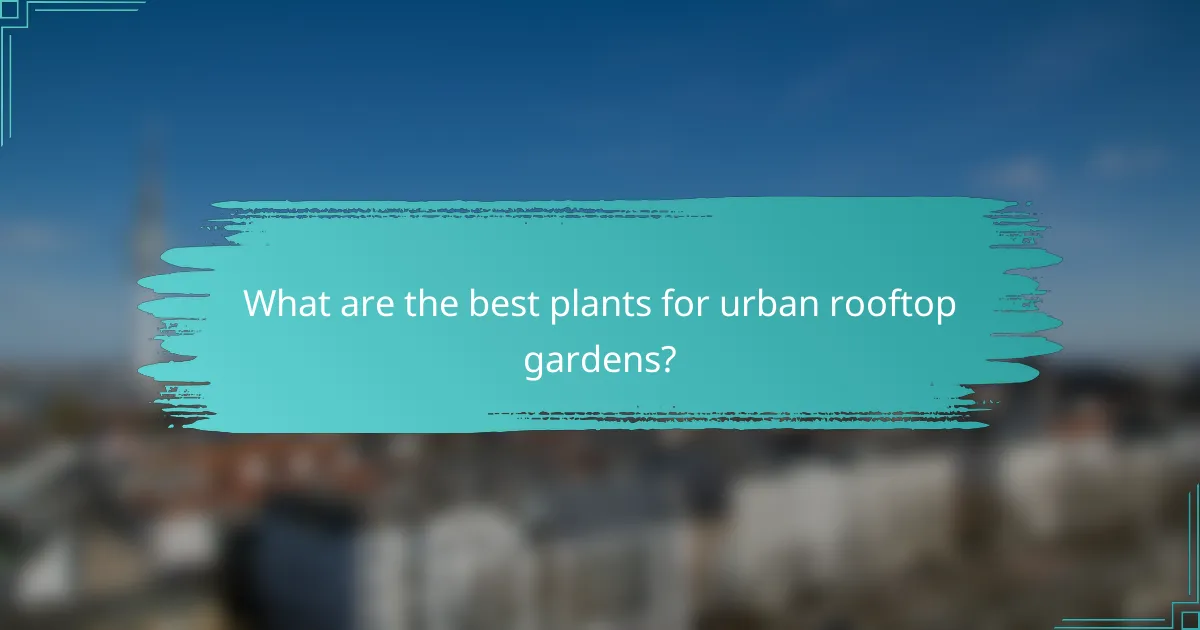
What are the best plants for urban rooftop gardens?
The best plants for urban rooftop gardens are those that thrive in limited soil, withstand wind, and require minimal maintenance. Consider a mix of native plants, colorful flowers, and functional herbs to create a vibrant and practical garden space.
Native plants for low maintenance
Native plants are ideal for urban rooftop gardens as they are adapted to the local climate and soil conditions, requiring less water and care. Examples include species like coneflower, black-eyed Susan, and sedum, which can thrive in containers or garden beds.
Choosing native plants can reduce the need for fertilizers and pesticides, making your garden more sustainable. Additionally, they support local wildlife, such as pollinators, enhancing the ecological value of your rooftop space.
Colorful flowering plants for aesthetics
Colorful flowering plants can significantly enhance the visual appeal of your rooftop garden. Consider options like petunias, geraniums, and marigolds, which provide vibrant colors and can bloom throughout the growing season.
When selecting flowering plants, think about their sunlight requirements and blooming periods to ensure a continuous display of color. Grouping plants with complementary colors can create a striking visual effect, making your rooftop a pleasant retreat.
Herbs for functionality and fragrance
Herbs are a practical addition to any rooftop garden, offering both culinary uses and aromatic benefits. Popular choices include basil, rosemary, and mint, which can thrive in pots and provide fresh ingredients for cooking.
Incorporating herbs can also enhance the sensory experience of your garden, as many herbs release delightful fragrances. Additionally, they can deter pests naturally, reducing the need for chemical treatments and promoting a healthier garden environment.
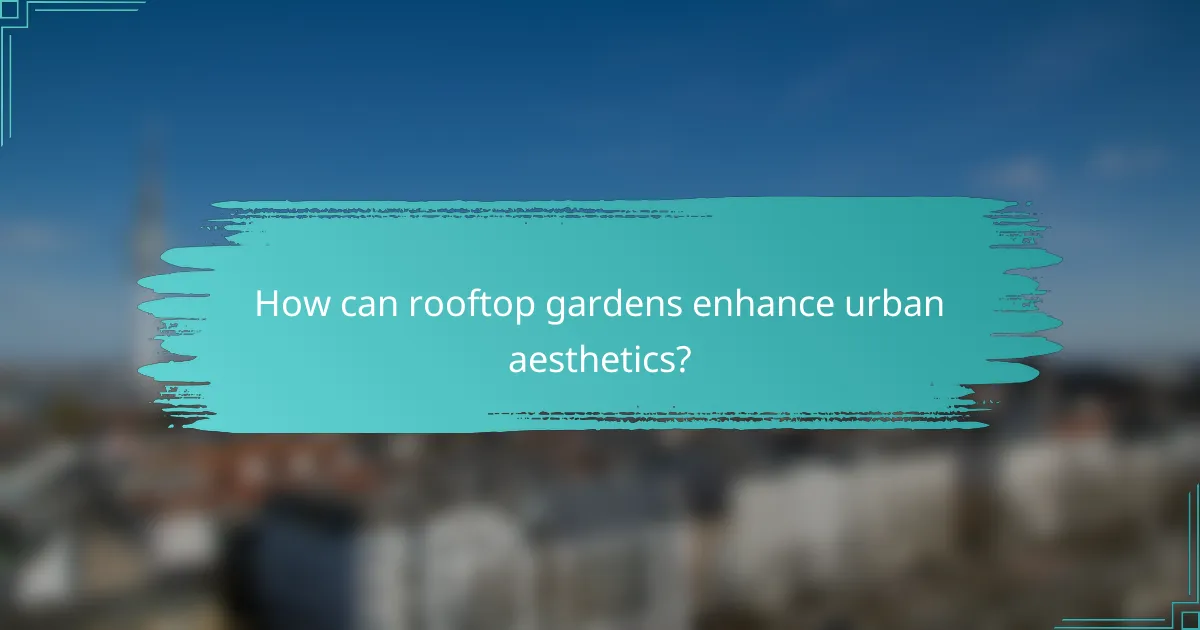
How can rooftop gardens enhance urban aesthetics?
Rooftop gardens significantly enhance urban aesthetics by transforming bland rooftops into vibrant green spaces that contribute to the overall beauty of the city. They provide a visual contrast to the hard surfaces of buildings, improving the skyline and creating a more inviting atmosphere.
Improving visual appeal of buildings
Rooftop gardens can dramatically improve the visual appeal of buildings by adding layers of color and texture. Greenery softens the harsh lines of architecture, making structures appear more approachable and integrated with nature. Simple plant choices, such as flowering perennials or ornamental grasses, can create stunning visual displays throughout the seasons.
Consider using a variety of plant heights and colors to create depth and interest. Vertical gardens or trellises with climbing plants can further enhance the aesthetic, drawing the eye upward and making the building stand out in the urban landscape.
Creating green spaces in concrete jungles
In densely populated urban areas, rooftop gardens serve as essential green spaces that provide refuge from the concrete environment. These gardens not only improve air quality but also offer habitats for local wildlife, contributing to biodiversity in the city. Incorporating native plants can enhance this effect while requiring less maintenance.
When designing a rooftop garden, consider the available space and sunlight. Even small areas can be transformed into lush retreats with container gardening or raised beds, allowing residents to enjoy nature amidst the urban sprawl.
Incorporating art and design elements
Integrating art and design elements into rooftop gardens can elevate their aesthetic appeal and create unique experiences for visitors. Features such as sculptures, decorative pathways, or water elements can serve as focal points, encouraging exploration and interaction. Thoughtfully placed seating areas can invite relaxation and socialization.
When selecting art pieces, consider the overall theme of the garden and how they complement the natural surroundings. Local artists can provide unique touches that reflect the community’s culture, making the rooftop garden a distinctive urban landmark.
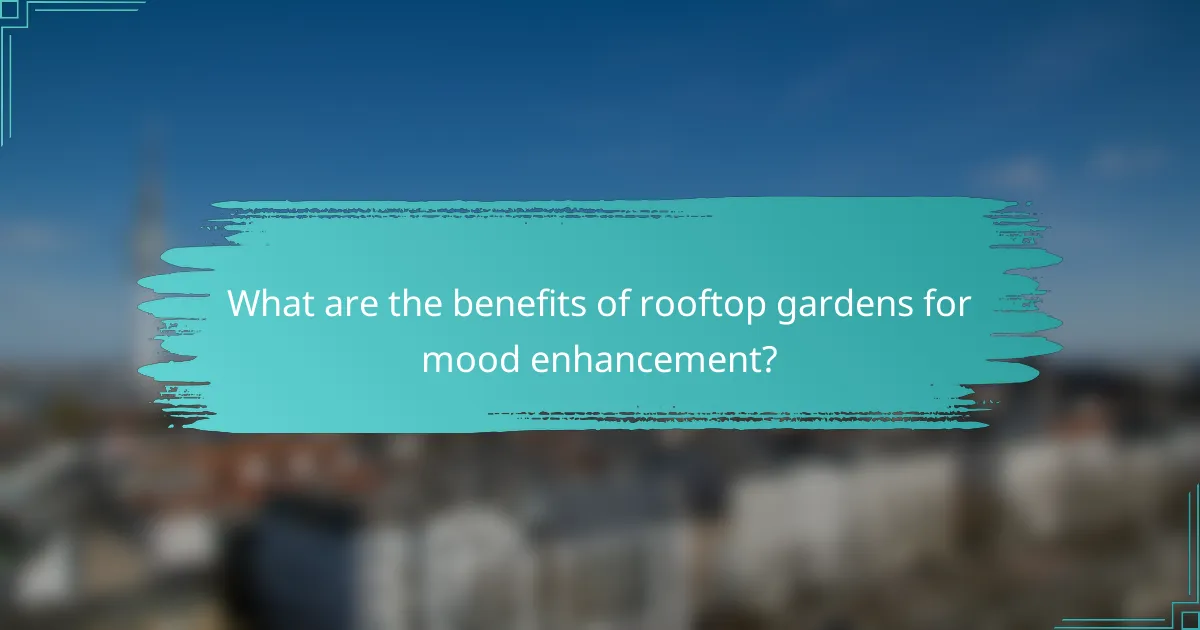
What are the benefits of rooftop gardens for mood enhancement?
Rooftop gardens significantly enhance mood by providing a natural escape from urban environments. They offer a unique blend of greenery, fresh air, and a connection to nature, which can improve overall mental well-being.
Reducing stress through greenery
Greenery has been shown to lower stress levels by promoting relaxation and reducing anxiety. The presence of plants can create a calming atmosphere, making rooftop gardens ideal for unwinding after a busy day.
Incorporating a variety of plants, such as ferns and flowering species, can enhance this effect. Aim for a mix that thrives in your local climate, ensuring year-round greenery and seasonal blooms.
Providing a space for relaxation
A rooftop garden can serve as a personal retreat, offering a peaceful environment for relaxation. Adding comfortable seating, such as lounge chairs or hammocks, encourages users to spend more time outdoors.
Consider including features like water elements or soft lighting to create a serene ambiance. These additions can further enhance the relaxation experience, making it an inviting space for meditation or reading.
Encouraging social interactions
Rooftop gardens can foster social connections by providing a communal space for gatherings. They are perfect for hosting small events, barbecues, or casual meet-ups with friends and neighbors.
Designing the garden with communal seating and shared amenities can promote interaction. Consider integrating features like a fire pit or outdoor kitchen to enhance the social atmosphere and encourage frequent use.
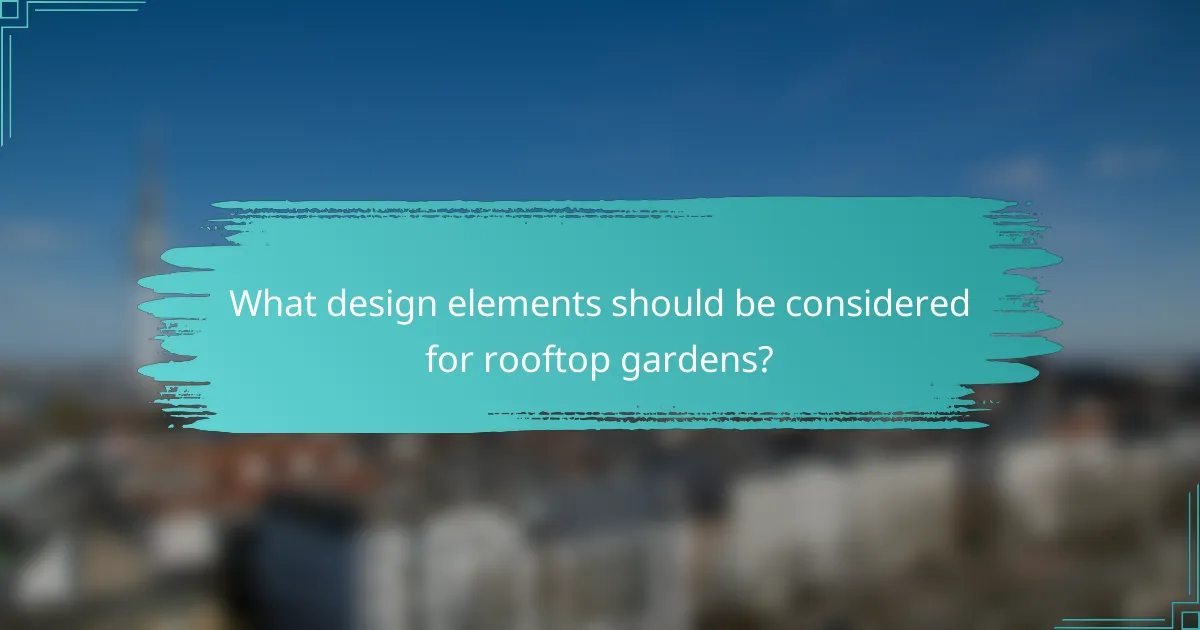
What design elements should be considered for rooftop gardens?
When designing rooftop gardens, key elements include layout, plant selection, water features, and lighting. These components work together to create a functional and aesthetically pleasing space that enhances urban living.
Layout and spatial planning
Effective layout and spatial planning are crucial for maximizing the use of limited rooftop space. Start by assessing the available area and determining zones for seating, planting, and pathways. Consider using modular furniture and vertical gardens to optimize space.
Incorporate pathways that allow easy movement while maintaining accessibility. Use raised beds or containers to define areas and create visual interest. Remember to account for weight limits and ensure proper drainage to prevent water accumulation.
Water features for ambiance
Water features can significantly enhance the ambiance of a rooftop garden. Options include small fountains, ponds, or even simple water bowls that attract birds and provide soothing sounds. Choose features that fit the scale of your garden and are easy to maintain.
When selecting a water feature, consider the local climate and potential evaporation rates. In warmer areas, a recirculating system can help conserve water. Ensure that any electrical components are weatherproof and comply with local safety regulations.
